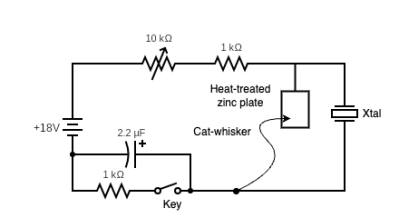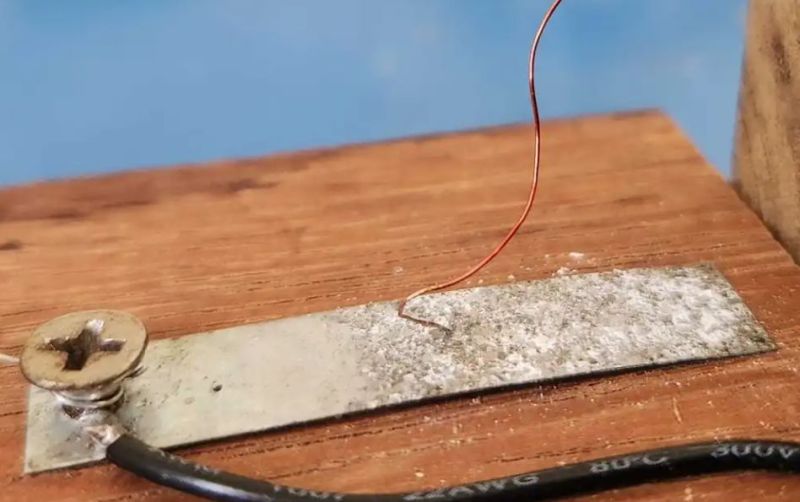
During the first half of the 20th century radio technology was booming, albeit restricted by the vacuum tube technology of the time which made radios cumbersome in size and power needs. The development of a solid state alternative to the vacuum tube was in full swing, but the first version pioneered by [Oleg Losev] in the form of crystal radios failed to compete. Even so these ‘crystal radios’ laid much of the groundwork for subsequent research. The ease of creating this type of radio also makes it a fun physics experiment today, as [Ashish Derhgawen] demonstrates in a blog post.
In the January 1925 issue of Radio News the theory of the circuit is explained by [Oleg Losev] himself (page 1167). At the core is a material capable of negative resistance, as a non-linear (non-Ohmic) material, which means that the current passing through them decreases as voltage increases over part of their I-V curve. This enables it to work as an amplifier or oscillator. After the cessation of research on crystal radio technology by [Losev] and others, the negative resistance diode was rediscovered in 1957 with the tunnel diode.
The semiconductor used here is zinc oxide (zincite), which is obtained by taking a strip of zinc and heating it with a blow torch. This creates spots of zinc oxide on the strip, which can then be contacted by the ‘cat’s whisker’ contact. In the circuit, the clock is created by the 4 MHz crystal and a 10 kOhm potentiometer is used to adjust the biasing. What [Ashish] noticed is how fussy this type of oscillator is, as where the cat’s whisker touches on the strip has to be often adjusted, presumably due to how imperfect the formed semiconductor material is. This was one of the main downfalls of crystal radios during the 1920s and onwards, as though they were cheap, they couldn’t amplify very much and required constant maintenance.
Regardless, as a practical demonstration of early solid-state semiconductor research it remains a wonderful example. meanwhile if you’re interested in [Losev]’s life and untimely end, we wrote a biography of him back in 2017.















Would it work with copper oxide also?
While it is possible to make a ‘Copper-CopperOxide-Copper’ (Metal-Insulator-Metal) tunnelling diode, these are hard to make at home apparently.
Just a cautionary note: Inhalation of zinc oxide fumes can cause metal fume fever. This acute overexposure to zinc oxide through the respiratory system causes flu like symptoms that can be severe. Chronic overexposure to zinc oxide can result in death. It is also wise to weld in a well ventilated area, even when using a respirator.
Holding your breath works well too.
It’s called “the zinc shakes”. Treat with large quantities of milk. Better yet, have a fan outdoors to blow the fumes away from you and avoid getting poisoned.
This is certainly the most informative post I’ve read on HaD.
Thank you.
Where would we be without zinc oxide? These warnings weren’t in that funny short scene in Kentucky Fried Movie, a spoof of mid century educational films showing what bad happens when it’s absent. Good sunblock still.
SImpsons did it pretty good too… https://www.youtube.com/watch?v=U1iCZpFMYd0
I can’t listen to the radio because I’m severely allergic to cat and dog fur.
That’s a pitty – I just love cats and it would be very sad if I would be allergic.
Did someone mention cats???
https://photos.app.goo.gl/yzxdx7FJzX8wDGDW7
You could try substituting a fur seal whisker :) Not sure of the Digikey part number though…
Oh yes, fur seal whisker is a perfect substitute and makes excellent tunnel diodes! :D
https://media.licdn.com/dms/image/D4D22AQFhxQswzOB1RA/feedshare-shrink_800/0/1709366411198?e=1712793600&v=beta&t=mkURv6g2CMXq6aUmQMsNoZNgGLbZGxxAIB9xXMFLtNs
Does it have to be a zinc strip all the way through? How about galvanized steel? It’s a lot more common to have lying around.
They used to use razor blades for this in WW2. They had blued ones that worked right out of the box. I’ve read that regular, non-blued ones can be used by leaving them out to rust a bit. I would think hitting it with a torch would blue it for a quicker solution. I suppose that’s similar to the trick here with the zinc strip.
The linked article about quantum tunneling transmitters mentions, “Anyone with a propane torch and a few scraps of galvanized sheet metal laying around can easily make a negative resistance device. With this device, it is possible to make very simple RF oscillators, audio oscillators and even amplifier circuits. It is almost like making your own transistor.”
Sounds encouraging.
Galvanized steel works perfectly.
I’m glad to see that no cats were harmed in the making of this project.
Hi, I’d just like to mention that early crystal radio sets were very elegant at times.
Like pieces of fine furniture. Not everyone was using fox hole radios all the time.
Making a high-end crystal radios aka detector radios was a kind of craftsmanships.
> This was one of the main downfalls of crystal radios during the 1920s and onwards, as though they were cheap, they couldn’t amplify very much
Crystal radios can’t amplify AT ALL, they’re just a detector.
More zinc-oxide and other non-standard hackery can be found here: http://www.sparkbangbuzz.com/